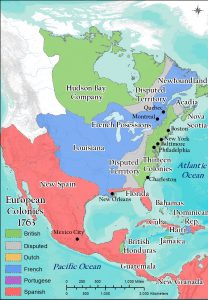5 Historical Geography –
Concepts and Terminology
“Geography explains the past, illuminates the present, and prepares us for the future. What could be more important than that?”
– Michael Palin, actor, travel writer and documentarian, and former president of the Royal Geographical Society
 A place’s geography and history are inseparable. Each world region has been shaped by its own unique historical forces, which will be discussed in the following regional chapters. Here, we will examine some historical processes of the last few centuries that have had global ramifications.
A place’s geography and history are inseparable. Each world region has been shaped by its own unique historical forces, which will be discussed in the following regional chapters. Here, we will examine some historical processes of the last few centuries that have had global ramifications.
European Exploration, Industrialization, and Colonization
In the 15th century, Europe emerged from the Middle Ages. The era that followed, known as the Renaissance, was characterized by significant technological, artistic, scientific, and economic progress, as well as a shift from feudalism to capitalism. This new economic system inspired European governments and a rising merchant class to seek faster trade routes to markets and resources, particularly those in Asia. In 1488, Portuguese ships rounded the southern tip of Africa, opening an era of European sea trade with Asia via the Indian Ocean. Four years later, Spanish ships arrived in the Americas, leading to the establishment of the first permanent European colonies there.
 This Age of Exploration would mark the beginning of five centuries of European dominance of global economics and politics. Portugal colonized Brazil, and Spain colonized much of the rest of mainland Latin America. Britain and France established colonies in North America, while Spain, France, Britain, the Netherlands, and Denmark colonized the Caribbean. These same growing European empires increasingly controlled global trade, with a number of them establishing colonial footholds in Africa and Asia.
This Age of Exploration would mark the beginning of five centuries of European dominance of global economics and politics. Portugal colonized Brazil, and Spain colonized much of the rest of mainland Latin America. Britain and France established colonies in North America, while Spain, France, Britain, the Netherlands, and Denmark colonized the Caribbean. These same growing European empires increasingly controlled global trade, with a number of them establishing colonial footholds in Africa and Asia.
This era had devastating consequences for much of the world’s population, notably the millions of Native Americans who died as the result of warfare, displacement, and the introduction of Old World diseases to the Americas. This era also marked the beginning of the trans-Atlantic slave trade, in which millions of Africans were forcibly removed from their homelands to serve as labor in colonial America.
Europe, however, reaped enormous benefits during this period. Control of global trade, easy access to resources, and the colonization of the Americas flooded the coffers of European governments and merchants, making Europe by far the world’s wealthiest region. Industrialization would further cement Europe’s position as the center of global economic, political, and technological power. Beginning in Britain in the early 1700s, the Industrial Revolution represented a shift away from traditional production methods, in which manufactured goods were produced in small quantities, and largely handmade (the term “manufactured” literally means “handmade”). After industrialization, manufactured goods were produced in much greater quantities using machines. Characterized by the rise of the factory and significant advances in metallurgy, chemistry, and engineering, the Industrial Revolution enabled Britain to produce goods at a scale previously unimaginable. Industrial production soon spread to much of the rest of western Europe. Within a century, the region dominated global manufacturing.
The wealth and technology of the Industrial Revolution would create an appetite in Europe for yet more markets and resources, and it would also give Europe the ability to obtain them, this time through colonization in Africa and Asia. By 1900, those continents had been almost entirely colonized by European empires. Britain, France, the Netherlands, Belgium, Germany, Italy, Portugal, Spain, and Russia were the leading imperial powers.
Forms of Colonization

The European colonies took on different forms. One form of colonization was the settler colony. As its name implies, a settler colony is one to which Europeans permanently migrated. The United States, Canada, southern South America, South Africa, Australia, and New Zealand are all examples of former settler colonies. Although these countries contain indigenous populations and people whose ancestors were not European, they are still sometimes referred to as Neo-Europes, because the socially, politically, and economically dominant groups were, and largely still are, of European descent. Because many of the original European immigrants to these places were farmers, they were interested in settling in areas that had climates and soils similar to those found in Europe. As a result, the settler colonies were typically located, like Europe, in the mid-latitudes.
Another form of European colonization was the mercantile colony. While, Europeans did, of course, reside in their mercantile colonies, these places would never become the permanent homes for millions of European settlers. Instead, these mercantile colonies were primarily exploited for their natural resources and labor. The mercantile colonies tended to be located in the tropics and subtropics, largely because they could produce crops such as cotton, tobacco, tea, coffee, sugar cane, and other agricultural products that could not be easily produced in Europe. Examples of European mercantile colonies include British India (India, Pakistan, and Bangladesh), French Indochina (Vietnam, Cambodia, and Laos), the Dutch East Indies (Indonesia), as well as much of China and mainland Latin America, and nearly all of the Caribbean and Sub-Saharan Africa.
Many mercantile colonies were formal colonies, directly controlled by a European empire. Some mercantile colonies were informal colonies, which remained nominally independent, but which fell under the economic and political sway of one or more foreign powers. A prominent example of an informal colony was China in the late 19th and early 20th centuries. Although China had a sovereign government which maintained a modest level of control over its own territory, vast sections of the country were informally governed by British, French, German, Japanese, and Russian forces.
Of course, history and geography often defy tidy categorization. Some countries, such as Canada and New Zealand, are clear-cut examples of settler colonization. Others, like Jamaica and Nigeria, are prototypical examples of mercantile colonization. Some countries, though, are not so easily categorized. For example, southern Brazil, with its history of mass European immigration, resembles a settler colony. Northern Brazil, however, with its legacy of slavery and the mass export of tropical agricultural products, might better be defined as a mercantile colony. Even the United States, a prime example of settler colonization, demonstrated some characteristics of a mercantile colony, particularly in the slave plantation economy of the antebellum South.
The Legacy of Colonization
Most of Europe’s major American colonies gained their independence in the 18th and 19th centuries. A second wave of decolonization occurred in the mid-20th century, with most of Europe’s African and Asian colonies gaining their independence. By the end of the 20th century, the age of colonization was largely over.
Still, the legacy of colonization plays an outsized role in shaping the current global structure of wealth and poverty. By the end of the colonial period, most countries could be put into one of three categories: European countries, former settler colonies (or Neo-Europes), and former mercantile colonies. Most European and Neo-European countries are today generally wealthy. Most former mercantile colonies are today relatively poor.
Europe’s wealth is not surprising. The intent of colonization was to enrich the colonizer, not the colony. For centuries, colonization provided European merchants unfettered access to cheap resources, cheap labor, and vast markets. It also filled the treasuries of imperial governments. Meanwhile, emigration to the settler colonies allowed Europe to reap the benefits of industrialization while suffering comparatively little fallout from the resulting population explosion. Even those European countries that did not build large overseas empires benefitted indirectly from colonization. Sweden, for example, was never a serious imperial power outside of Europe, but Sweden’s neighbors were. Wealth generated in British, French, Dutch, Belgian, and German colonies enabled merchants from those imperial countries to purchase more Swedish goods.
Most Neo-Europes today are also quite wealthy. Although the settler colonies attracted scores of relatively poor immigrants, many of the initial European settlers were privileged, arriving with the advantages of European wealth, technology, and trade connections. More importantly, these settler colonies also had imperial ambitions. Examples can be found in three of Britain’s most prominent settler colonies. Just as Britain built up wealth and power by conquering and subjugating indigenous people to exploit their land and resources, so did the settlers in the United States, Canada, and Australia. All three of these countries expanded across entire continents, conquering and subjugating indigenous people to exploit their land and resources, creating vast land empires of their own.
On the other end of the economic spectrum are former mercantile colonies, which account for most of the world’s poorest countries. While colonized, these places exported cheap raw materials to their colonizer, while importing far more expensive manufactured goods from their colonizer. This, of course, put the mercantile colonies at a serious economic disadvantage. Today, even though most of these countries have been independent for more than a half century, many of them remain mired in the same economic relationship that subjugated them during the colonial period. They still primarily export cheap raw materials to wealthy countries, and they still import many of their manufactured goods. This is a situation known as neo-colonialism.
A notable exception in this era of European and neo-European dominance was Japan. Because of Japan’s self-imposed isolationism from early 1600s to the mid-1800s, European powers were unable gain a colonial foothold in that country. As a result, Japan was able to avoid the pitfalls of mercantile colonization. In fact, by the early 20th century, Japan was joining the ranks of the world’s most powerful countries by industrializing and building a formidable mercantile empire of its own.
The World Wars and the Cold War
At the dawn of the 20th century, Europe was the unquestioned center of global political, military, industrial, and economic power. Fifty years later, the era of European dominance was over, largely as a result of two costly world wars. World War I (1914-1918) and World War II (1939-1945) cost millions of lives, and left much of Europe in ruins. The human and economic carnage of the wars left most of Europe’s major imperial powers unwilling or unable to maintain their colonial possessions. Although the traditional powers of western Europe would recover and remain wealthy, influential countries, they are no longer globally dominant.
The end of World War II ushered in the Cold War, a geopolitical struggle between two superpowers that would dominate global political affairs for the next fifty years. The United States emerged from World War II as a significant economic and military power. Its ambition was to be at the center of the global economic order, which had been dominated for centuries by a capitalist economic system. The United States’ primary adversary during the Cold War was the Union of Soviet Socialist Republics (USSR), commonly known as the Soviet Union. Based in the old Russian Empire, the Soviet Union was the world’s first communist state. Unlike capitalism, which is rooted in private property and a free economic market, communism is based on the idea of communal ownership of property and the workers’ control of the economy. In Soviet-style communism, the government controlled all property and means of production (farms, factories, businesses, etc.). Just as the United States wished to be at the center of a global capitalist economic system, the Soviet Union wished to be at the center of a global communist economic system.
Berlin, Germany, was often seen as the metaphorical heart of the Cold War. In the wake of World War II, the city was divided into an American-affiliated capitalist west and Soviet-dominated communist east, eventually to be separated by the infamous Berlin Wall. Berlin was a microcosm of Germany, which was similarly divided between a communist east and capitalist west. Germany was, in turn, a microcosm of Europe, which was divided between a capitalist West, aligned with the United States, and a communist East, dominated by the Soviet Union. This division between competing capitalist and communist interests would soon spread throughout much of the rest of the world.
The Cold War took its name from the fact that there was never a serious military engagement between the United States and the Soviet Union. This was a very good thing, of course, considering that both superpowers would construct nuclear arsenals large enough to annihilate human civilization. Nevertheless, the term “Cold War” is misleading. Although it was fought with limited violence in places like Berlin, it resulted in plenty of bloodshed. The Cold War would kill millions of people, most of them in what are known as “proxy wars.”
A proxy war is a conflict in which the combatants are supported by larger, more powerful outside forces. A typical Cold War proxy war involved an American-backed, pro-capitalist government fighting Soviet-backed communist revolutionaries. In other cases, a Soviet-armed communist government would be fighting American-backed rebels. From 1945 to 1991, Cold War-fueled conflicts raged throughout the world, with the fiercest fighting occurring in East Asia, Southeast Asia, North Africa and Southwest Asia, Central Asia, Sub-Saharan Africa, Latin America and the Caribbean. American troops were occasionally involved in these conflicts, notably in Korea and Vietnam, as were Soviet troops, notably in Afghanistan. But these wars were largely fought with American and Soviet money and weapons, rather than manpower.
The Cold War ended between 1989 (the fall of the Berlin Wall) and 1991 (the collapse of the Soviet Union). Nevertheless, the last three decades have been deeply influenced by the governments, strategic alliances and, unfortunately, the animosities that were formed and shaped by the Cold War. It is quite likely that the next few decades will continue to feel its chill.
American Hegemony
If the Cold War was defined by the clash of two superpowers, the post-Cold War era has been defined by the dominance of the one superpower that survived. In many ways, the United States got what it wished for. It emerged from the Cold War at the center of a global capitalist economy. Its political, economic, and military power is unequalled by any other country. This age of American dominance, or hegemony, may well extend through the twenty-first century and beyond.
Still, this unprecedented power is not without its liabilities. American military interventions, particularly in Iraq and Afghanistan, have led to deep-seeded resentment of American foreign policy in much of the world. Additionally, many Americans have grown increasingly isolationist, questioning the benefits of America’s global military commitments. And the United States’ continued dominance is by no means guaranteed. A unified Europe, a resurgent Russia, and an emerging China are all examples of potential checks on American power.
Did You Know?
The United States Navy’s dominance of the world’s oceans was a decisive advantage during the Cold War. It permitted the U.S. to project its military power anywhere in the world, and to protect (and sometimes disrupt) global trade routes. This advantage continues. The United States has twenty aircraft carriers, more than all of the other navies in the world combined, and its total ship tonnage is twice that of China’s navy, which is the world’s second largest.
Cited and additional bibliography:
Banas, Steven. 2020. “American Colonizers.” College of DuPage. GIS class at College of DuPage. Instructor Joseph Adduci.



